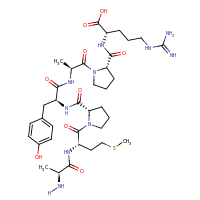-
Interaction
| AccNo. |
21840 |
Score |
0.86 |
| Name |
AMPYA_HSVSMC |
Environment |
in vitro / culture |
| Kd |
1.0 |
Organism |
Homo sapiens (human) |
|
Peptide
| AccNo. |
21724 |
| Name |
AMPYA |
| Organism |
N/A |
| Constraint |
disulfide |
| Sequence |
AMPYAPR

|
| Origin |
phage display |
| Form |
phage |
| Internalized |
no |
| Unnatural |
no |
| Imaging |
no |
| Is Motif |
no |
|
Interactor
| AccNo. |
21574 |
| Name |
HSVSMC |
| Description |
human saphenous vein smooth muscle cells |
| Organism |
Homo sapiens (human) |
| Type |
cell |
|
Experiment
| AccNo. |
21793 |
Classification incorrect?
Click the corresponding button to vote. Your vote
is used to improve the automatic classification.

|
| CA |
CVD |
DM |
APO |
ANG |
MI |
BD |
|
| 0.54 |
0.56 |
0.69 |
0.75 |
0.58 |
0.64 |
0.53 |
Vote |
 |
 |
 |
 |
 |
 |
 |
Yes |
 |
 |
 |
 |
 |
 |
 |
No |
|
| Name |
PD_11 |
| Detection |
filamentous phage display, MI:0048 |
| Source |
PDF |
Text Id |
11 |
| Journal |
Mol Ther. 2004 Feb;9(2):198-208. |
| Title |
Development of efficient viral vectors selective for vascular smooth muscle cells. |
| Authors |
Work LM, Nicklin SA, Brain NJ, Dishart KL, Von Seggern DJ, Hallek M, Büning H, Baker AH |
| Text |
The vascular smooth muscle cell (SMC) is integral to the pathogenesis of neointimal formation associated with late vein graft failure, in-stent restenosis, and transplant arteriopathy. Viral vectors transduce SMC with low efficiency and hence, there is a need for improvement. We aimed to enhance the efficiency and selectivity of gene delivery to human SMC. Targeting ligands were identified using phage display on primary human saphenous vein SMC with linear and cyclic libraries. Two linear peptides, EYHHYNK (EYH) and GETRAPL (GET), were incorporated into the HI loop of adenovirus (Ad) fibers and the capsid protein of adeno-associated virus-2 (AAV-2). Exposure of human venous SMC to EYH-modified (but not the GET-modified) Ad vector resulted in a significant increase in transgene expression levels at short, clinically relevant exposure times. Similarly, the EYH-modified AAV vector resulted in enhanced gene transfer to human venous SMC but not endothelial cells in a time- and dose-dependent manner. The EYH-modified AAV vector also enhanced (up to 70-fold) gene delivery to primary human arterial SMC. Hence, incorporation of EYH into Ad and AAV capsids resulted in a significant and selective enhancement in transduction of SMC and has implications for improving local gene delivery to the vasculature. |
| Mesh Terms |
Adenoviridae/genetics; Adenoviridae/physiology; Capsid Proteins/genetics; Capsid Proteins/metabolism; Cells, Cultured; Cysteine Endopeptidases/metabolism; Dependovirus/genetics; Dependovirus/physiology; Genetic Vectors/genetics; Heparin/metabolism; Humans; Multienzyme Complexes/metabolism; Muscle, Smooth, Vascular/cytology; Muscle, Smooth, Vascular/virology; Organ Specificity; Peptide Library; Peptides/genetics; Peptides/metabolism; Proteasome Endopeptidase Complex; Protein Engineering; Protein Transport; Saphenous Vein |
References
|